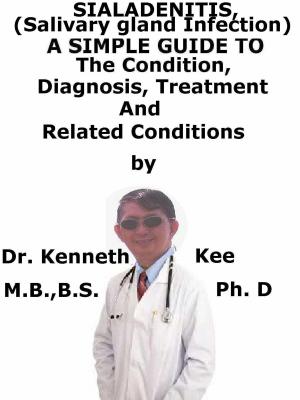Legionnaire's Disease, A Simple Guide To The Condition, Treatment And Related Conditions
Nonfiction, Health & Well Being, Health, Ailments & Diseases, Respiratory, Medical, Infectious Diseases, General| Author: | Kenneth Kee | ISBN: | 9781370657209 |
| Publisher: | Kenneth Kee | Publication: | November 18, 2016 |
| Imprint: | Smashwords Edition | Language: | English |
| Author: | Kenneth Kee |
| ISBN: | 9781370657209 |
| Publisher: | Kenneth Kee |
| Publication: | November 18, 2016 |
| Imprint: | Smashwords Edition |
| Language: | English |
Legionnaire disease is an infection of the lungs and airways caused by Legionella bacteria.
Legionnaire's Disease is an acute, infectious disease of the respiratory tract caused by the bacillus Legionella pneumophilia, a Gram negative, non-sporulating aerobic micro-organism.
The bacteria that cause Legionnaire disease have been found in water delivery systems.
They can survive in the warm, moist air conditioning systems of large buildings including hospitals.
Most cases are caused by the bacteria Legionella pneumophila.
The rest of the cases are caused by other Legionella species.
The bacteria are found mostly in soil and water.
Legionnaire's Disease is transmitted through the air or in dust associated with movement of soil or contaminated air from air conditioner units.
It is highly infectious
The organism enters the blood and then enters the cells of the lower respiratory tract
The infections occur in persons of all ages but peak incidence is 50-60 years.
Symptoms start off with:
1. Sudden onset of malaise - General discomfort, uneasiness or ill feeling (malaise)
2. High fever 39-40 degrees centigrade
3. Chills and rigors
4. Headache
5. Dry coughs (Cough that does not produce much sputum or mucus)
Diagnosis is from sputum culture or indirect legionna bacterial antibody (>1.256).
Treatment is by antibiotics e.g., ciprofloraxin, erythromycin
Besides antibiotics, the following will help:
1. Oxygen and Steam inhalation
2. Cough mixtures
3. Avoid smokes, dust, dry air, sudden temperature change
The earlier the illness is treated with antibiotic medication, the better the likely outcome.
The illness is serious and can be fatal, but it is not contagious
The source of the germs (bacteria) in an outbreak is usually a man-made water distribution system where the bacteria have multiplied in great numbers.
Warm storage tanks where the water stagnates are ideal for legionella bacteria to multiply.
The bacteria thrive in water temperatures between 25°C and 45°C - about 35°C is the optimum temperature.
This means that Legionnaires' disease can be caught from:
a. Piped water especially hot water, in large buildings where long runs of pipe work can be a source of the bacteria.
b. Circulating water droplets in air-conditioning and cooling systems, cooling towers and evaporative condensers.
c. Whirlpool spas
d. Nebulizers and humidifiers (including some types of breathing equipment) if topped up with contaminated tap water
Sources where temperatures allow the bacteria to thrive include hot-water tanks, cooling towers and evaporative condensers of large air-conditioning systems such as those commonly found in hotels and large office buildings.
TABLE OF CONTENT
Introduction
Chapter 1 Legionnaire's Disease
Chapter 2 Interesting Facts of Legionnaire's Disease
Chapter 3 Treatment of Legionnaire's Disease
Chapter 4 Pneumonia
Chapter 5 Tuberculosis
Chapter 6 Mycoplasma
Chapter 7 Bronchitis
Epilogue
Legionnaire disease is an infection of the lungs and airways caused by Legionella bacteria.
Legionnaire's Disease is an acute, infectious disease of the respiratory tract caused by the bacillus Legionella pneumophilia, a Gram negative, non-sporulating aerobic micro-organism.
The bacteria that cause Legionnaire disease have been found in water delivery systems.
They can survive in the warm, moist air conditioning systems of large buildings including hospitals.
Most cases are caused by the bacteria Legionella pneumophila.
The rest of the cases are caused by other Legionella species.
The bacteria are found mostly in soil and water.
Legionnaire's Disease is transmitted through the air or in dust associated with movement of soil or contaminated air from air conditioner units.
It is highly infectious
The organism enters the blood and then enters the cells of the lower respiratory tract
The infections occur in persons of all ages but peak incidence is 50-60 years.
Symptoms start off with:
1. Sudden onset of malaise - General discomfort, uneasiness or ill feeling (malaise)
2. High fever 39-40 degrees centigrade
3. Chills and rigors
4. Headache
5. Dry coughs (Cough that does not produce much sputum or mucus)
Diagnosis is from sputum culture or indirect legionna bacterial antibody (>1.256).
Treatment is by antibiotics e.g., ciprofloraxin, erythromycin
Besides antibiotics, the following will help:
1. Oxygen and Steam inhalation
2. Cough mixtures
3. Avoid smokes, dust, dry air, sudden temperature change
The earlier the illness is treated with antibiotic medication, the better the likely outcome.
The illness is serious and can be fatal, but it is not contagious
The source of the germs (bacteria) in an outbreak is usually a man-made water distribution system where the bacteria have multiplied in great numbers.
Warm storage tanks where the water stagnates are ideal for legionella bacteria to multiply.
The bacteria thrive in water temperatures between 25°C and 45°C - about 35°C is the optimum temperature.
This means that Legionnaires' disease can be caught from:
a. Piped water especially hot water, in large buildings where long runs of pipe work can be a source of the bacteria.
b. Circulating water droplets in air-conditioning and cooling systems, cooling towers and evaporative condensers.
c. Whirlpool spas
d. Nebulizers and humidifiers (including some types of breathing equipment) if topped up with contaminated tap water
Sources where temperatures allow the bacteria to thrive include hot-water tanks, cooling towers and evaporative condensers of large air-conditioning systems such as those commonly found in hotels and large office buildings.
TABLE OF CONTENT
Introduction
Chapter 1 Legionnaire's Disease
Chapter 2 Interesting Facts of Legionnaire's Disease
Chapter 3 Treatment of Legionnaire's Disease
Chapter 4 Pneumonia
Chapter 5 Tuberculosis
Chapter 6 Mycoplasma
Chapter 7 Bronchitis
Epilogue















